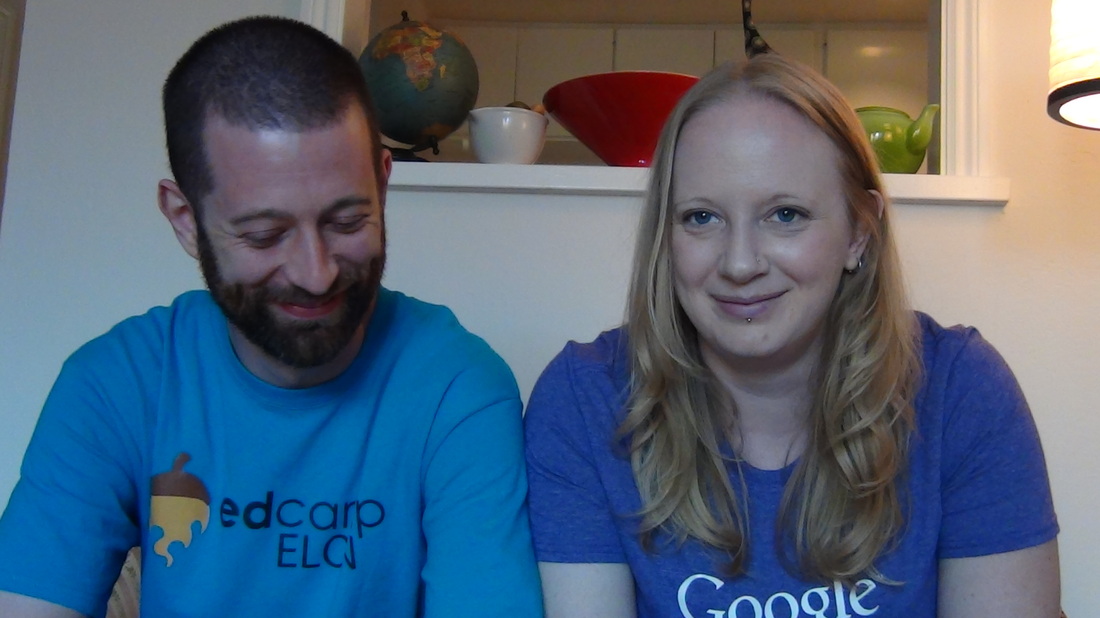But when Andrew burst into my life nine months ago, the way I read (along with everything else) changed. Suddenly, it wasn’t just me reading. We read books the other recommended, then talked about it as we read. Texted quotes and commentary, thoughtful emails and Direct Messages on Twitter about the meaning of certain passages, and the relevance to our own lives...all of that made reading something that was no longer just a refuge where I could live in a world of (at least partially) my own creation.
When I first flipped my class, I got an idea while I watched a reality television show to do something similar to how they engaged viewers. Throughout the episode, the hashtag for the show appeared in the corner, and viewers were encouraged to tweet their comments in real time. So I stole that idea and used it for reading and watching video in my English 10 class last year. They used Today’s Meet as a backchannel, and I saw their level of engagement increase substantially. They were asking questions that showed more trouble with comprehension than I had any idea existed. And instead of me answering all the questions, they started answering each other’s questions. Kids who refused to talk in class were suddenly revealed to be incredibly engaged and possessing more knowledge than anyone realised. It was actually one of the most beautiful things I’ve ever done in class.
And that’s how we read Night. I made videos of myself reading each chapter using ShowMe, and we watched them in class. Students participated over Today’s Meet (we had 1:1 netbooks last year in my classroom). At the end of the book, every kid passed the assessment...because they actually were engaged in the reading.
And when I started at Redwood, I threw those ideas out for the most part because we were no longer 1:1 and my students were supposedly avid independent, motivated readers.
And a semester later, I’m wondering why I abandoned everything that worked so beautifully for the sake of a little less technology and what turns out to be a group of students who aren’t used to reading for English class. They are, however, much more adept at using sparknotes and the internet to help them avoid reading. And they have fooled most of their teachers for a long time, or have simply had a teacher resigned to the fact that her students wouldn’t read what was assigned. I think all English teachers understand that it's pretty hard to get students to read and focus and comprehend and be excited about books. And with the influx of technology, attention spans get shorter and teenagers struggle to find as much meaning in Catcher in the Rye as they do in Call of Duty or Facebook. It's not a problem of this school, or this state, or whatever. It's a universal problem, at least in American culture.
I had an idea a few weeks ago to have students produce an interactive book of the text they’re reading. It follows the “Why Read?” inquiry unit we did at the start of the course, because now we’ve read one book together and so we have some experience using the strategies they selected. And frankly, the way teenagers read has changed.
In an era where they can get high-quality summaries and analysis of most books on the traditional canon for high school literature, and where they’ve come to believe that reading books for school rarely yields anything but pain and suffering, how can we possibly wonder why they choose to do their hours of other homework without even glancing over the pages assigned in their English novel?
But here’s the problem: you can’t analyse what you can’t understand. And you can’t understand what you don’t read. So we’re at an impasse.
Now, I’ve had two relatively successful novel units. We are just wrapping up Death of a Salesman in American Literature, and we are just finished with Night in Humanities. So for the end product, it makes sense to go back to the original inquiry question: Why Read?
But the more interesting question to me is how my students believe they can help other teens read. And that’s where the idea for the interactive book comes into its own. An interactive book, created by the students in my class for the book they are reading or have just finished, could put in features like video explanations of difficult passages, or hyperlinked vocabulary or historical terms, or summaries to start and end the chapter, or focus questions so students can read for deeper analytical meaning. All of those things would help me as a reader, and my guess is that my students would be helped as well. But it still doesn’t solve the problem of how to leverage the ability of books to create community.
That’s where the idea for the CoFlipBooks Reads The Fault in Our Stars came from. We wanted to know what would happen if we got together a group of friends and made videos for each of the chapters that would serve to start a discussion and deepen our own connection to and understanding of the book. We’ve already got an introduction video and a video for chapter one and it’s been amazing so far.
We’re working on translating this for use in the classroom, and how it could fit into an interactive book. We don’t have all the answers yet, but that doesn’t matter. Part of blogging for me is sharing what is in process, rather than just what is finished product.
So when school starts on Monday, we will start talking about constructing an interactive book that will help students read socially and with thoughtfulness and depth. I’d love to hear what you think about how that should work.
And please watch our book club videos! And read with us! And create video responses to any of the chapter videos!


 RSS Feed
RSS Feed
